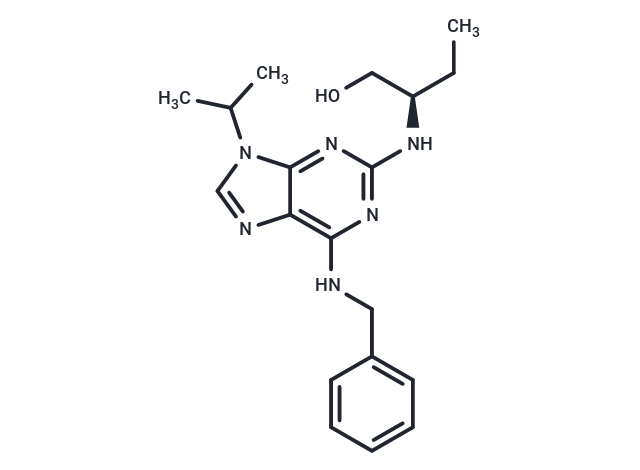Shopping Cart
- Remove All
 Your shopping cart is currently empty
Your shopping cart is currently empty

Seliciclib (Roscovitine) is a potent inhibitor of Cdk2/cyclin E (IC50=0.1 µM). Seliciclib also inhibits Cdk7/cyclin H, Cdk5/p35 and Cdc2/cyclin B (IC50=0.49/0.16/0.65 µM). Seliciclib has antitumor activity.

| Pack Size | Price | Availability | Quantity |
|---|---|---|---|
| 5 mg | $40 | In Stock | |
| 10 mg | $50 | In Stock | |
| 25 mg | $102 | In Stock | |
| 50 mg | $129 | In Stock | |
| 100 mg | $172 | In Stock | |
| 200 mg | $237 | In Stock | |
| 1 mL x 10 mM (in DMSO) | $50 | In Stock |
| Description | Seliciclib (Roscovitine) is a potent inhibitor of Cdk2/cyclin E (IC50=0.1 µM). Seliciclib also inhibits Cdk7/cyclin H, Cdk5/p35 and Cdc2/cyclin B (IC50=0.49/0.16/0.65 µM). Seliciclib has antitumor activity. |
| Targets&IC50 | CDK5-p35:0.16 μM (cell free), ERK2:14 μM (cell free), CDK2-CyclinE:0.7 μM (cell free), CDC2-cyclinB:0.65 μM (cell free), CDK2-CyclinA:0.7 μM (cell free) |
| In vitro | METHODS: MM cell lines MM.1S, OPM2, RPMI, U266, Dox-40, LR5, MM1.R were treated with Seliciclib (10-100 µM) for 24 h. Cell viability was measured by MTT assay. RESULTS: Seliciclib produced dose-dependent cytotoxicity within 24 h with an IC50 in the range of 15-25 µM.[1] METHODS: Mantle cell lymphoma (MCL) cells Granta-519, NCEB-1, REC-1, and JeKo-1 were treated with Seliciclib (25-50 µM) for 24-48 h. Cell cycle was detected by Flow cytometry. RESULTS: Accumulation of G2-M phase cells was detected in Granta-519, NCEB-1 and REC-1 cells after treatment with Seliciclib at IC50 dose for 24 h, and JeKo-1 cells at 48 h as compared to controls. After treatment with Seliciclib for 24 and 48 h, sub-G1 peaks were significantly increased in all cells except Granta-519, indicating apoptosis. [2] |
| In vivo | METHODS: To assay antitumor activity in vivo, Seliciclib (300 mg/kg/d) was administered orally to B6D2F1 mice bearing Glasgow osteosarcoma at Zeitgeber time (ZT) 3, 11, or 19 for 5 days. RESULTS: Seliciclib reduced tumor growth by 55% after ZT3 or ZT11 administration and by 35% after ZT19 administration compared with controls. [3] |
| Kinase Assay | Kinases activities were assayed at 30°C in buffer C (unless otherwise specified). Blank values were substracted from the data and activities calculated as the molar amount of phosphate incorporated in protein acceptor during a 10-min incubation. Controls were performed with appropriate dilutions of Me2SO. In a few cases, phosphorylation of the substrate was assessed by autoradiography after SDS/PAGE [1]. |
| Cell Research | L1210 cells taken from exponentially growing cultures in RPMT-1640 medium supplemented with 10% foetal calf serum, penicillin and streptomycin, were counted using a hemocytometer, seeded at 5X10^4 cells/ml in tissue-culture 96-wells plates in the presence or absence of various concentrations of roscovitine or olomoucine and incubated at 37°C under 5% CO,. For reversion of the roscovitine effect, L1210 cells cultured two days in the presence or absence of roscovitine were washed in phosphate-buffered saline to remove any trace of the drug, counted and reseeded in fresh medium containing no drug. Cell growth was monitored daily using the microculture tetrazolium assay. Cell cycle analysis was performed on cells that were fixed in ethanol, treated with 100 μg/ml RNase and stained with propidium iodide. We used a Coulter EPICS Elite flow cytometer for acquisition and the Multicycle software for analysis of the data. All assays were performed in triplicate and experiments repeated at least twice [1]. |
| Animal Research | Male athymic nude mice (5-6 weeks old) were obtained from the National Cancer Institute. Mice were housed in the animal facilities of the Georgetown University Division of Comparative Medicine. All animal work was done under protocols approved by the Georgetown University Animal Care and Use Committee. Mice were inoculated s.c. into the right posterior flank with 4 × 10^6 A4573 cells in 100 μL of Matrigel basement membrane matrix. Xenografts were grown to a mean tumor volume of 129 ± 30 mm^3. Roscovitine was first dissolved in either absolute methanol or DMSO (1 volume). A carrier solution was produced by using a diluent containing 10% Tween 80, 20% N-N-dimethylacetamide, and 70% polyethylene glycol 400. Mice were randomized into two groups (six animals per group) and treatment was initiated. One group was treated with roscovitine, administered as a single daily i.p. injection, at a dose of 50 mg/kg, for either 5 days or two 5-day series with a 2-day break in between. The control group received i.p. injections of the carrier solution following identical schedules. All mice were sacrificed by asphyxiation with CO2. Roscovitine-treated mice were euthanized either 7 days after the first injection or up to 4 weeks after completion of the treatment. At those times, tumors were removed, measured, and prepared for TUNEL assays. Primary tumor volumes were calculated by the formula V = (1/2)a × b2, where a is the longest tumor axis and b is the shortest tumor axis. Data are given as mean values ± SE in quantitative experiments. Statistical analysis of differences between groups was done by a one-way ANOVA followed by an unpaired Student's t-test [4]. |
| Alias | R-roscovitine, Roscovitine, CYC202 |
| Molecular Weight | 354.45 |
| Formula | C19H26N6O |
| Cas No. | 186692-46-6 |
| Smiles | CC[C@H](CO)Nc1nc(NCc2ccccc2)c2ncn(C(C)C)c2n1 |
| Relative Density. | 1.3 g/cm3 |
| Storage | store at low temperature | Powder: -20°C for 3 years | In solvent: -80°C for 1 year | Shipping with blue ice. | ||||||||||||||||||||||||||||||||||||||||
| Solubility Information | H2O: < 1 mg/mL (insoluble or slightly soluble) DMSO: 50 mg/mL (141.06 mM), Sonication is recommended. Ethanol: 6 mg/mL (16.93 mM), Sonication is recommended. | ||||||||||||||||||||||||||||||||||||||||
Solution Preparation Table | |||||||||||||||||||||||||||||||||||||||||
Ethanol/DMSO
DMSO
| |||||||||||||||||||||||||||||||||||||||||

Copyright © 2015-2025 TargetMol Chemicals Inc. All Rights Reserved.